,
This year, 2007, marks Tapissary’s 30th anniversary. To celebrate, I’ve been making adjustments to the grammar. The journal is my practice sheet where I merge linguistic invention with my daily experiences.
Cette année 2007, correspond au 30ème anniversaire de ma langue inventée de Tapissary. Pour le fêter, mon cadeau c'est le plaisir d'expérimenter avec des rajustements de la grammaire. Ici, dans les pages du journal, je fonds l'invention linguistique avec mes expériences quotidiennes. Mes formules telles que [< >] +/\, sont les indicateurs de la grammaire des cycles.
今年の2007年で、タピセリ語の三十番目の誕生日です。祝うために、私の考案した文法を合わせてある。こちらの日記でわ、言語学の考案に私の日常生活をかき混ぜています。(<>)+/\ などの公式は私のサイクルの文法を指し示す。
,
Hansel and Grethel: On this 18th page of the journal, I have just finished translating the Grimm's fairy tale of Hansel and Grethel in parallel text from English to Tapissary. With the information from the mini lessons, and the notes following each translation, you will be able to use this story as a first reader. Paragraphs 1 thru 16 are written in the linear form of Tapissary which is very easy to compare with English. Starting with paragraph 17, I'm experimenting with a new form of the cyclic grammar. The çelloglyphs are the same, so you can still follow along. The word order and declensions as seen in the transliterations below each Tapissed text will be explained at a later date.
The formulae you see preceding phrases, such as [=] +/\, refer to the cyclic grammar. They explain how the grammar tags onto the cyclic meaning of the sentence.
Beginning with paragraph 21 on Nov 4, I’m introducing the back and forth writing system (called boustrophedon) which is the usual way to read and write Tapissary. I will only use the most common backward çelloglyphs in the Hansel and Grethel story. The backward çelloglyphs are color coded. While reading the transliteration, you will be able to identify the vocabulary by matching its color. The long introductory çelloglyphs are called the warp, and I have rendered them in red. The çelloglyphs that are pinned into the long warps are called weft. The rest of the text is in black pencil, as usual. I’m using color and directional arrows as training wheels to show the direction that the lines are to be read.
.
.
tapissed entries
,
Dec 18 2007
,
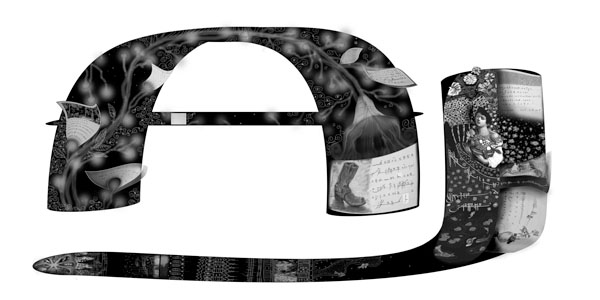
[> <] +/\ The first of 4 massive çelloglyphs for the “Hieroglyphic Collages” exhibit was complete as of yesterday. [< >] +/\ By Friday, the printers should have a test strip ready for my approval. +| Each photoshop collage will measure 3 feet by 6 feet. +/\ Click on the EXHIBITS link in the Contents page to see the first çelloglyph including its details.
The first of 4 massive çeghlloglyph for the “Hieroglyphic Collaghge” exhûbit is complete as yyesterday. By Friday, a test strip se prighnter should have ready for my approval. Each photoshop collage meajeasure 3 foot by 6 foot. D’you on the EXHIGHBIT link in the Coghntent page click essee tra first çelloglyph including its deghtail.
Hier, le premier hiéroglyphe massif parmi quatre qui vont trouver leur place dans l’expo “Collages Hiéroglyphiques” a été fini. Ce Vendredi, j’évaluerai un test de l’image photoshop chez l’imprimeur. La taille va mesurer un peu moins d’un mètre par deux. Pour voir ce premier hiéroglyph et ses détails, cliquez sur EXPOSITIONS sur la page ‘Contents’.
,
,
Dec 10 2007
,
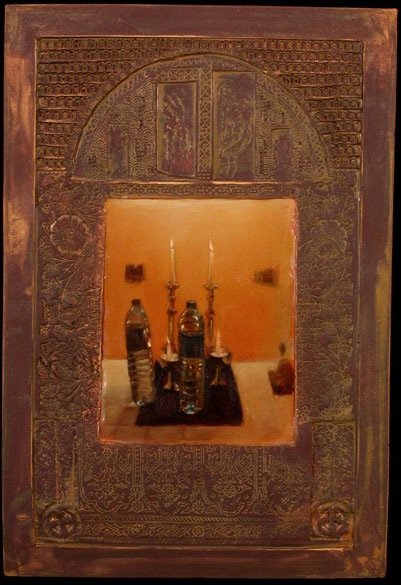
.
[> <] +/\ In 2000 I sculpted this clay tile with tiny wooden and metal tools, a eucalyptus acorn, and a batik stamp. +/\ I also made my own negative relief figures in polymer clay, baked that until it was hard and impressed it into the clay tile. +/\ Then after the panel was dry, it was glazed and fired. +∆ When that was complete,+/\ I painted the still life you see in the center with oil paint. +| It is the kitchen of my friend’s apartment in Paris. +| There are two plastic drinking bottles of water and candles. [< >] +V The apartment has since changed hands, [< >] +__ and the painting is lost. [> <] +| The work was one of several small oil paintings I’d made on sculpted tiles for an exhibit I’d done called ‘Oils on Tablets’.
In 2000, sculpt I this clay tillë with tiny wooden and metal tooghl, a eucalyptus acorn, and a batik stamp. Also I my own negative relief findighgurrë in polymer clay make, bake thét until it was hard and impress ût into se clay tile. Then after the panel in drô be, it in glâzed and in fôred be. When that was it complete, I ge still lôfe paint you see in the center with oil paint. It is the kitchen ymy friendin apartment in Paris. There are two plastic drinking boghttle ywater and caghndle. Since chasange se haghndined apartment, and ge nemissing gehet a nepainting. Ge work was one yseveral small oil paighnting I mandrake on sculpted tighle for an exhibit I dondro called “Oighl on Taghblet”.
2000年で、上のタイルを色々な手作りの道具で彫刻した。ポリマーで印を彫った後で、その印を堅いになるまでオーブンで焼いて、タイルの柔らかい粘土の中に刻印した。そして、そのタイルは乾いた後で、それを釉薬して、窯に焼けた。次に、釉薬の表面の上に、油絵をかいた。友達のパリでのアパートの台所です。絵の中に二本のプラスチック製の瓶や蝋燭がある。今度、友達はあのアパートをもう持っていないで、この油絵のタイルも見えなくなる。私の前の展覧会にこの瓶の絵は別のタイル達の油絵と入れて展示された。”石板の油絵” と言う展覧会でした。
En 2000, j’ai sculpté cette tuile en terre cuite avec de petits utils en bois et métal, des baies d’eucalyptus, et des impreintes de batik. Aussi ai-je fabriqué des reliefs figuratifs au négatif en polymère, les ai fait cuire jusqu’à l’endurcissement, puis j’ai appuyé l’empreinte contre la tuile toujours mouillée. Après que la céramique soit sèche, j’applique la glaçure, et finalement, je la fait cuire au four à une température de 1000˚C. Après la cuisson, j’ai peint en huiles la nature morte que vous apercevez au centre de la tuile. Le sujet, c’est la cuisine dans l’apartement d’un de mes amis à Paris. Voici deux bouteilles d’eau en plastique et des bougis. Depuis ce temps, l’apartement tient un nouveau propriétaire, et on ne sait plus où se trouve la peinture. Elle appartenait à mon exposition nommée “Tablettes aux Huiles” dans laquelle, j’avais fait plusieurs de ces formats céramique à la peinture.
,
,
Dec 06 2007
.
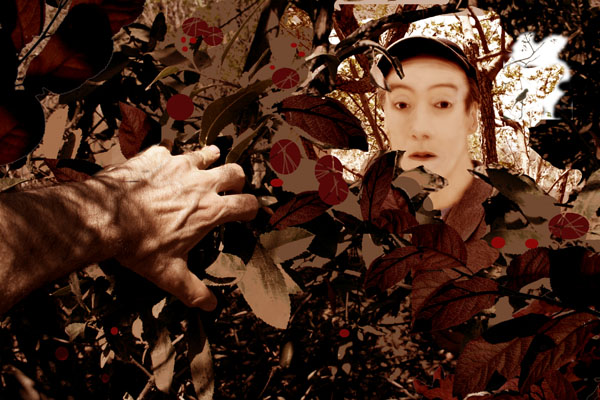
.
I had announced quite a while ago in the stories section of this site, that I was writing a piece called “The Woodsman and the Deer”. I had begun three of the images months back, but had to put the project on hold as I addressed other priorities. My schedule continues to be full, so this story will have to wait till sometime next year. I’ve posted one of the images above. It is a combination of photos and drawing. I took all the photos, then altered them on the computer, and added drawing elements throughout. Recently I’ve been adding some French and Japanese notes on my site to make it more widely accessible. My hope is that those visitors will forgive errors. I’ll get back to posting Tapissary about once a week as soon as I am able. It is a time consuming process due to the photography and jpeg construction. The French and Japanese phrases are easier to post as I can type the translations directly onto my computer. There is no Tapissed font, so it is all written from scratch. Scroll down this page, and any previous journal pages to see entries written in Tapissary.
J’etais en train d’écrire une histoire qui s’appelle “le menuisier et le cerf”. Je suis contraint de retarder le projet jusqu’a l’année prochaîne. Mais vous pouvez voir une des images en haut. C’est une composition mixte de la photographie et du dessin.
”山男と 鹿”と言う童話を途中で書いていましたが、来年までにその企画を終わるのは時間がありません。上の 画像をごらんなさい。こちらのは 撮影と 図面です。
,
,
Nov 20 2007
,
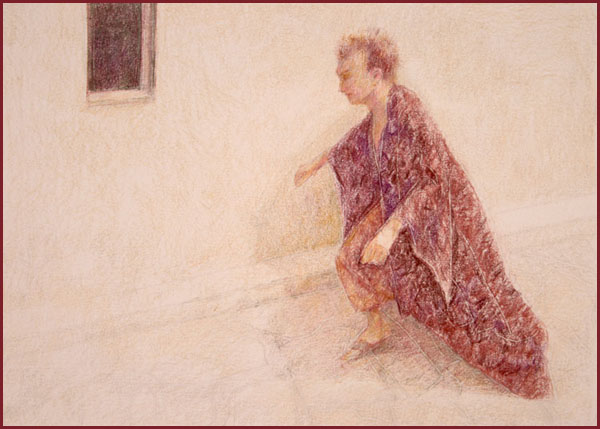
,
I’m working on my exhibit for 2008 (see the exhibit listing on the CONTENTS page for more info). Along with the focus I must place on that project, there is also another major responsibility that must be taken care of, and is very time consuming. The interruption breaks my daily posting of the journal. For the time being, I'm putting up an image without a Tapissed text. Today’s post is my most recent pencil drawing. I’m thinking of making a series about magicians on paper, in a style influenced by Persian miniatures, but with Tapissed texts accompanying the images.
The drawing above measures 5” x 7”
,
,
Nov 13 2007
HANSEL AND GRETHEL
paragraph 30
,
1. [=] +/\ Then they began to run, and, +/\ bursting into the house, +<> they fell into their father's arms.
2. [≠] --V He had not had one happy hour --/\ since he had left the children in the forest;
3. [=] +__ and his wife was gone. +/\ Grethel shook her apron,
4. +<> and the pearls and precious stones rolled out upon the floor,
5. +<> and Hansel threw down one handful after the other out of his pocket.
6. +∆ Then all their sorrows were ended,
7. +∆ and they lived together in great happiness.
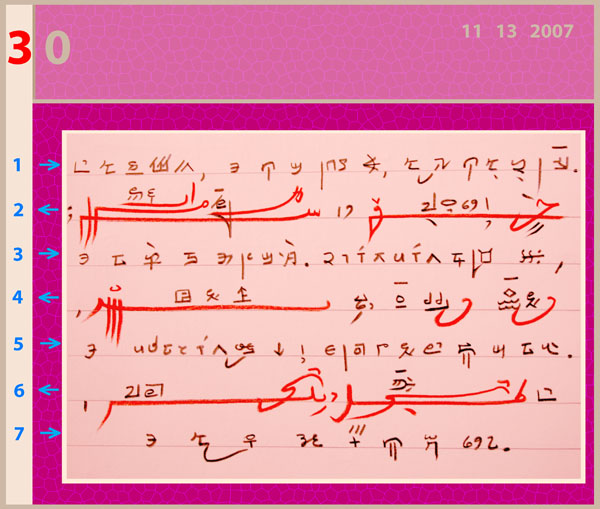
Transliteration
1. Then they did begin run, and into the smazing burst, they fell into their fatherin aghrme.
2. Handraves one happy hoùrined him since he se childrendrene in the forest leave;
3. and his n’wife was gone from the nonplace. Grethel her aprondone shake,
4. and ge peaghrl and precious stoghne rile out upon ge floor,
5. and Hansel threw down one handfule after ge other out yhis pocket.
6. Then all their soghrrow were they ended,
7. and they lived together all in great happiness.
.
.
Nov 12 2007
HANSEL AND GRETHEL
paragraph 29
,
1. [=] +| So the duck came to them, +| and Hansel sat himself on,
2. +| and bade his sister sit behind him. "No," +/\ answered Grethel,
3. [≠] +| "that will be too much for the duck; +| she shall take us over one at a time."
4. +/\ This the good little bird did, +/\ and when both were happily arrived on the other side,
5. +/\ and had gone a little way, +/\ they came to a well-known wood,
6. +/\ which they knew the better every step they went,
7. +<> and at last they perceived their father's house.
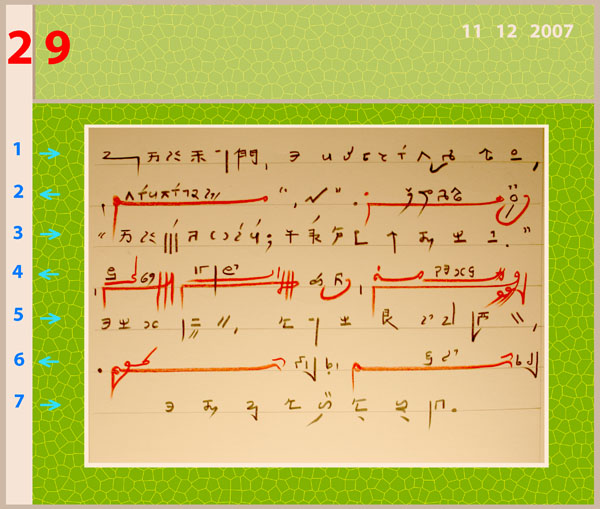
Transliteration
1. So se duck came to them, and Hansel sat himself on,
2. and bade his sister sit behind him. “No,” did answer Grethel,
3. “se duck beje too much for that; she tajake us over one at a time.”
4. Thoss se good little bird do, and when both on the other cote be happily arrive,
5. and a little wendrey go, they to a well known woondoode come,
6. whichte they know better every stendepe they go,
7. and at last they percüve their fatherin smaze.
.
.
Nov 11 2007
HANSEL AND GRETHEL
paragraph 28
.
1. [=] +/\ "We must be off now," said Hansel, [≠] +/\ "and get out of this enchanted forest."
2. [=] +/\ But when they had walked for two hours +<> they came to a large piece of water.
3. [≠] +| "We cannot get over," said Hansel; [≠] +__ "I can see no bridge at all."
4. [=] +__ "And there is no boat, either," said Grethel; +| "but there swims a white duck,
5. +/\ and I will ask her to help us over." +/\ And she sang:
6. +| "Little Duck, good little Duck, Grethel and Hansel, here we stand;
7. +| There is neither stile nor bridge, [≠] +/\ Take us on your back to land."
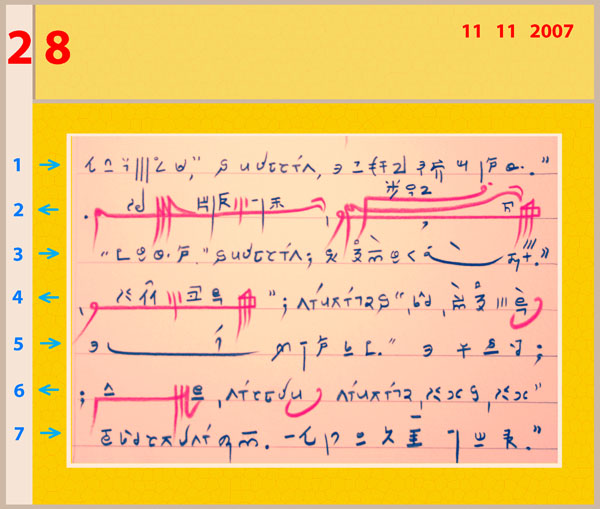
Transliteration
1. “We do must be off now,” said Hansel, and this enchanted forest out yist get.”
2. But when they for 2 heundreure walk, they came to a large pice ywater.
3. “Over can gets us,” said Hansel; “Ge no nonbridge can see nonme at all.”
4. “And nonthere is no nonboat, either,” said Grethel; “but there swihim a white duck,
5. and I hejer ask t’ist help over.” And she did sing:
6. “Little Duck, good little Duck, Grethel and Hansel, here we stand;
7. There is neither stile nor bridge. De we thee on our baghck to land take.”
l
l
.[][][][][][][][][][][][][][][][][][][][][][][][]
.


